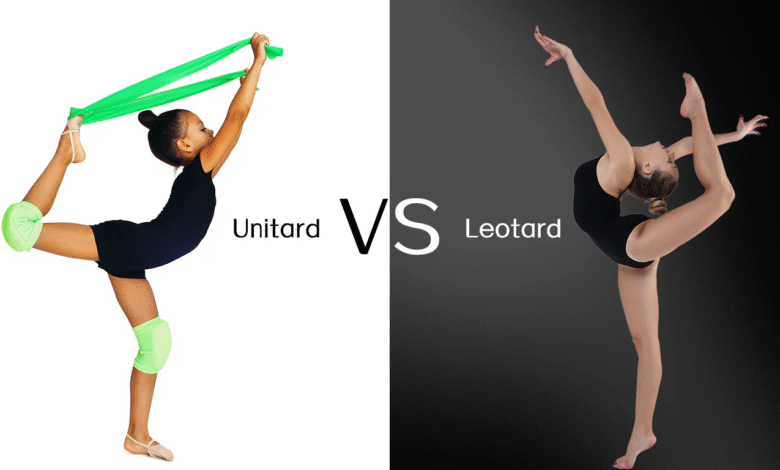Leotard vs Unitard: The Ultimate Guide to Choosing the Right Fit

Introduction
When browsing dancewear or athletic apparel, you’ve likely encountered both leotard vs unitard. While these form-fitting garments might seem similar at first glance, they serve different purposes and offer distinct advantages depending on your needs.
A leotard is a one-piece garment that covers the torso and typically ends at the hip, leaving the legs exposed. Think of what gymnasts wear during competitions or what dancers sport in ballet class. A unitard, on the other hand, extends coverage to include the legs, creating a full-body silhouette that covers from neck to ankle.
Both garments have earned their place in dance studios, gymnastics gyms, and fashion wardrobes worldwide. Understanding their unique characteristics will help you make the right choice for your specific activities and style preferences.
The History Behind These Athletic Staples
The leotard traces its origins to 19th-century France, named after acrobat Jules Léotard who performed daring trapeze acts in a revolutionary one-piece costume. His tight-fitting garment allowed for unrestricted movement while maintaining modesty a game-changer for performers of the era.
Initially, leotards were primarily worn by circus performers and later adopted by dancers who needed similar freedom of movement. The garment gained mainstream acceptance in the 1950s and 1960s as fitness culture grew and women began seeking more practical athletic wear.
Unitards emerged later, evolving from the leotard design during the mid-20th century. As dance styles became more diverse and athletic training intensified, performers needed full-body coverage that still provided the stretch and support of traditional leotards. The unitard answered this call, offering enhanced coverage while maintaining the performance benefits dancers and athletes required.
Both garments experienced a fashion renaissance during the aerobics craze of the 1980s, when celebrities like Jane Fonda popularized athletic wear as everyday fashion. This period cemented their place not just in studios and gyms, but in mainstream fashion culture.
Design and Features: What Sets Them Apart
Fabric Choices
Both leotards and unitards typically use similar stretch fabrics designed for movement and durability. Common materials include:
- Lycra and spandex blends: Offer maximum stretch and recovery
- Cotton blends: Provide breathability for casual wear
- Nylon composites: Deliver moisture-wicking properties for intense workouts
- Velvet and metallic fabrics: Add glamour for performance wear
The key difference lies in how much fabric is used. Unitards require additional material for leg coverage, which can affect the overall feel and weight of the garment.
Cut and Silhouette
Leotards focus on torso fit with various neckline options—crew neck, scoop neck, halter, or off-the-shoulder designs. The leg cut can be high, moderate, or boy-short style, affecting both coverage and the visual line of the legs.
Unitards extend this fitted silhouette down to the ankles, creating an unbroken line from shoulders to feet. This creates a streamlined appearance that many performers prefer for certain dance styles or athletic activities.
Style Variations
Leotards offer more variety in terms of back designs you’ll find racerback, tank, long-sleeve, and intricate strappy-back options. Color blocking and mesh inserts are also popular design elements.
Unitards tend to focus on overall silhouette rather than intricate details, though you can find options with mesh panels, cutouts, or color blocking that emphasize the body’s natural lines.
Functionality: Choosing Based on Your Activity
Dance Applications
In ballet, leotards are traditional and practical. They allow instructors to observe proper alignment and technique while giving dancers freedom of movement. Classical ballet schools often require specific leotard colors and styles as part of their dress code.
Contemporary and modern dance often embrace unitards for their clean lines and dramatic silhouette. The full-body coverage can enhance the visual impact of movement while providing consistent coverage during floor work.
Jazz and commercial dance styles work well with both options, depending on the specific choreography and desired aesthetic.
Gymnastics Considerations
Competitive gymnastics typically requires leotards, as they’re standard competition wear. The exposed legs allow judges to see proper form during routines, while the fitted torso ensures safety around apparatus.
Rhythmic gymnastics sometimes incorporates unitards, especially when working with certain apparatus where leg coverage might be beneficial.
Fitness and Training
For general fitness classes, personal preference often drives the choice. Leotards work well for activities like yoga or Pilates where leg movement needs to be observed. Unitards might be preferred for activities involving floor work or when additional coverage is desired.
Weighing the Pros and Cons
Leotard Advantages
Freedom of movement ranks as the top benefit. Without fabric around the legs, you can move without any restriction or potential bunching. Temperature regulation is also easier—your legs can breathe freely during intense workouts.
Versatility in styling gives leotards an edge for fashion-conscious wearers. You can easily pair them with skirts, shorts, or tights to create different looks for various occasions.
Leotard Drawbacks
Less coverage means they’re not suitable for all activities or comfort levels. Some people prefer more modest coverage, especially when bending or stretching extensively.
Unitard Advantages
Complete coverage appeals to many wearers who want full-body support and modesty. The seamless silhouette from neck to ankle creates a polished, professional appearance that many performers prefer.
Protection from friction and environmental factors makes unitards practical for certain activities. They can prevent skin irritation during floor work or provide warmth in cooler studios.
Unitard Disadvantages
Potential restriction around the ankles and legs might bother some wearers, especially those accustomed to unrestricted leg movement. The additional fabric can also trap more heat during intense activities.
Bathroom breaks require more effort and time compared to leotards—a practical consideration for long rehearsals or classes.
Styling Tips for Maximum Impact
Leotard Styling
Layer strategically to transition from studio to street. Add high-waisted jeans or a flowy skirt for casual outings. For dance class, pair with matching tights and leg warmers for a coordinated look.
Choose cuts that flatter your body type. High-cut legs can elongate shorter torsos, while boy-short styles provide more coverage and comfort for some body types.
Unitard Styling
Embrace the sleek silhouette by keeping accessories minimal. A simple cardigan or wrap can add coverage when needed without disrupting the clean lines.
For performance wear, focus on makeup and hair as your primary styling elements, since the unitard creates such a complete look on its own.
Consider footwear carefully. The full-length coverage means your shoes become a crucial part of the overall aesthetic.
Making Your Final Decision
Consider your primary activities when choosing between leotards and unitards. If you’re primarily doing ballet or gymnastics, leotards are likely your best bet. For contemporary dance, theatrical performance, or general fitness where you prefer more coverage, unitards might be ideal.
Think about your comfort level and personal style preferences. Some people simply feel more confident and comfortable with full-body coverage, while others prefer the freedom and versatility that leotards provide.
Budget might also play a role, as unitards typically cost more due to additional fabric and construction requirements.
Frequently Asked Questions
Can I wear a leotard as regular clothing?
Absolutely! Leotards work great as bodysuits under jeans, skirts, or shorts. They provide a smooth silhouette without the bunching that regular tops might cause.
Are unitards too warm for intense workouts?
This depends on the fabric and your personal temperature preferences. Look for moisture-wicking materials and consider the climate of your workout space. Many people find them comfortable even during intense activities.
Which option is better for beginners?
Both work well for beginners. Choose based on your comfort level with coverage and the specific requirements of your classes or activities.
How do I choose the right size?
Both garments should fit snugly without being restrictive. You should be able to move freely in all directions. When in doubt, consult the manufacturer’s sizing chart and consider trying on different brands, as fits can vary significantly.
Can men wear leotards and unitards?
Yes! Both garments are available in men’s styles and are commonly worn by male dancers, gymnasts, and fitness enthusiasts.
Finding Your Perfect Fit
Whether you choose a leotard vs unitard ultimately depends on your specific needs, activities, and personal preferences. Both garments offer unique benefits and have earned their place in athletic and performance wear for good reason.
Consider starting with one option based on your primary activity, then experiment with the other as your needs or interests expand. Many dancers and athletes eventually own both styles, choosing different options based on specific classes, performances, or moods.
The most important factor is finding a garment that makes you feel confident, comfortable, and ready to move. With the right choice, you’ll have a reliable foundation for whatever physical challenges or artistic expressions lie ahead.



